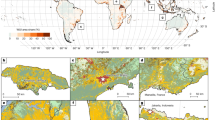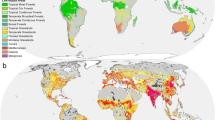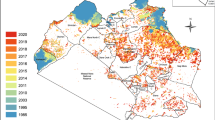Abstract
Construction and operation of research stations present the most pronounced human impacts on the Antarctic continent across a wide range of environmental values. Despite Antarctic Treaty Parties committing themselves to comprehensive protection of the environment, data on the spatial extent of impacts from their activities have been limited. To quantify this, we examined the area of building and ground disturbance across the entire continent using geographic information system mapping of satellite imagery. Here, we report the footprint of all buildings to be >390,000 m2, with an additional disturbance footprint of >5,200,000 m2 just on ice-free land. These create a visual footprint similar in size to the total ice-free area of Antarctica, and impact over half of all large coastal ice-free areas. Our data demonstrate that human impacts are disproportionately concentrated in some of the most sensitive environments, with consequential implications for conservation management. This high-resolution measurement of the extent of infrastructure across the continent can be used to inform management decisions to balance sustainable scientific use and environmental protection of the Antarctic environment.
This is a preview of subscription content, access via your institution
Access options
Access Nature and 54 other Nature Portfolio journals
Get Nature+, our best-value online-access subscription
$29.99 / 30 days
cancel any time
Subscribe to this journal
Receive 12 digital issues and online access to articles
$119.00 per year
only $9.92 per issue
Buy this article
- Purchase on Springer Link
- Instant access to full article PDF
Prices may be subject to local taxes which are calculated during checkout


Similar content being viewed by others
Data availability
The data associated with this manuscript are stored and accessible at the Australian Antarctic Data Centre (https://doi.org/10.4225/15/5ae7af0fb9fcf). A summarized excerpt of the GIS data is also available in Supplementary Table 1.
References
Protocol on Environmental Protection to the Antarctic Treaty (Antarctic Treaty Secretariat, 1991).
Tin, T. et al. Impacts of local human activities on the Antarctic environment. Antarct. Sci. 21, 3–33 (2009).
Chown, S. L. et al. Challenges to the future conservation of the Antarctic. Science 337, 158–159 (2012).
Shaw, J. D., Terauds, A., Riddle, M. J., Possingham, H. P. & Chown, S. L. Antarctica’s protected areas are inadequate, unrepresentative, and at risk. PLoS Biol. 12, e1001888 (2014).
Lee, J. R. et al. Climate change drives expansion of Antarctic ice-free habitat. Nature 547, 49–54 (2017).
Coetzee, B. W. T., Convey, P. & Chown, S. L. Expanding the protected area network in Antarctica is urgent and readily achievable. Conserv. Lett. 10, 670–680 (2017).
Chown, S. Polar collaborations are key to successful policies. Nature 558, 163 (2018).
Brooks, S. T., Jabour, J. & Bergstrom, D. M. What is ‘footprint’ in Antarctica: proposing a set of definitions. Antarct. Sci. 30, 227–235 (2018).
Poland, J. S., Riddle, M. J. & Zeeb, B. A. Contaminants in the Arctic and the Antarctic: a comparison of sources, impacts, and remediation options. Polar Rec. 39, 369–383 (2003).
Terauds, A. et al. Conservation biogeography of the Antarctic. Divers. Distrib. 18, 726–741 (2012).
Rintoul, S. et al. Choosing the future of Antarctica. Nature 558, 233–241 (2018).
Kennicutt, M. et al. Delivering 21st century Antarctic and Southern Ocean science. Antarct. Sci. 28, 407–423 (2016).
Kennicutt, M. C. et al. Polar research: six priorities for Antarctic science. Nature 512, 23–25 (2014).
The Antarctic Treaty (Antarctic Treaty Secretariat, 1959).
Jabour, J. in Health of Antarctic Wildlife: A Challenge for Science and Policy (eds Kerry, K. R. & Riddle, M.) 211–229 (Springer, 2009).
Convey, P. & Stevens, M. I. Antarctic biodiversity. Science 317, 1877–1878 (2007).
Chown, S. L. et al. The changing form of Antarctic biodiversity. Nature 522, 431–438 (2015).
Bergstrom, D. M., Hodgson, D. A. & Convey, P. in Trends in Antarctic Terrestrial and Limnetic Ecosystems: Antarctica as a Global Indicator (eds Bergstrom, D. M., Convey, P. & Huiskes, A. H. L.) 15–33 (Springer, 2006).
O’Neill, T. A. Protection of Antarctic soil environments: a review of the current issues and future challenges for the Environmental Protocol. Environ. Sci. Policy 76, 153–164 (2017).
Terauds, A. & Lee, J. R. Antarctic biogeography revisited: updating the Antarctic Conservation Biogeographic Regions. Divers. Distrib. 22, 836–840 (2016).
Burton-Johnson, A., Black, M., Fretwell, P. T. & Kaluza-Gilbert, J. An automated methodology for differentiating rock from snow, clouds and sea in Antarctica from Landsat 8 imagery: a new rock outcrop map and area estimation for the entire Antarctic continent. Cryosphere 10, 1665–1677 (2016).
Summerson, R. The Protection of Wilderness and Aesthetic Values in Antarctica. PhD thesis, Univ. Melbourne (2013).
COMNAP Antarctic Facilities List 31 March 2017 (Council of Managers of National Antarctic Programs, 2017).
Brooks, S. T. Developing a standardised approach to measuring the environmental footprint of Antarctic research stations. J. Environ. Assess. Policy Manage. 16, 1450037 (2014).
Wilson, K. J., Taylor, R. H. & Barton, K. J. in Antarctic Ecosystems (eds Kerry, K. R. & Hempel, G.) 183–190 (Springer, 1990).
Aislabie, J., Ryburn, J. & Sarmah, A. Hexadecane mineralization activity in ornithogenic soil from Seabee Hook, Cape Hallett, Antarctica. Polar Biol. 31, 421–428 (2008).
Ayres, E. et al. Effects of human trampling on populations of soil fauna in the McMurdo Dry Valleys, Antarctica. Conserv. Biol. 22, 1544–1551 (2008).
Tejedo, P. et al. Soil trampling in an Antarctic Specially Protected Area: tools to assess levels of human impact. Antarct. Sci. 21, 229–236 (2009).
Tejedo, P. et al. Trampling on maritime Antarctica: can soil ecosystems be effectively protected through existing codes of conduct?. Polar Res. 31, 10888 (2012).
Summerson, R. & Bishop, I. D. The impact of human activities on wilderness and aesthetic values in Antarctica. Polar Res. 31, 10858 (2012).
O’Neill, T. A., Balks, M. R. & López-Martínez, J. Visual recovery of desert pavement surfaces following impacts from vehicle and foot traffic in the Ross Sea region of Antarctica. Antarct. Sci. 25, 514–530 (2013).
Campbell, I. B., Claridge, G. G. C. & Balks, M. R. The effect of human activities on moisture content of soils and underlying permafrost from the McMurdo Sound region, Antarctica. Antarct. Sci. 6, 307–314 (1994).
O’Neill, T. A., Balks, M. R. & López-Martínez, J. Ross Island recreational walking tracks: relationships between soil physiochemical properties and track usage. Polar Rec. 51, 444–455 (2014).
Coetzee, B. W. & Chown, S. L. A meta-analysis of human disturbance impacts on Antarctic wildlife. Biol. Rev. Camb. Phil. Soc. 91, 578–596 (2016).
Klein, A. G. et al. The historical development of McMurdo Station, Antarctica, an environmental perspective. Polar Geogr. 31, 119–144 (2008).
Campbell, I. B., Claridge, G. G. C. & Balks, M. R. Short- and long-term impacts of human disturbances on snow-free surfaces in Antarctica. Polar Rec. 34, 15–24 (1998).
Southwell, C. et al. Spatially extensive standardized surveys reveal widespread, multi-decadal increase in East Antarctic Adélie penguin populations. PLoS ONE 10, e0139877 (2015).
Smith, R. L. Classification and ordination of cryptogamic communities in Wilkes Land, Continental Antarctica. Vegetatio 76, 155–166 (1988).
Pertierra, L. R., Hughes, K. A., Vega, G. C. & Olalla-Tarraga, M. A. High resolution spatial mapping of human footprint across Antarctica and its implications for the strategic conservation of avifauna. PLoS ONE 12, e0168280 (2017).
Hughes, K. A. How committed are we to monitoring human impacts in Antarctica? Environ. Res. Lett. 5, 041001 (2010).
Kennicutt, M. C. II et al. Temporal and spatial patterns of anthropogenic disturbance at McMurdo Station, Antarctica. Environ. Res. Lett. 5, 034010 (2010).
Convey, P., Hughes, K. A. & Tin, T. Continental governance and environmental management mechanisms under the Antarctic Treaty System: sufficient for the biodiversity challenges of this century? Biodiversity 13, 234–248 (2012).
Walton, D. W. H. & Shears, J. The need for environmental monitoring in Antarctica: baselines, environmental impact assessments, accidents and footprints. Int. J. Environ. Anal. Chem. 55, 77–90 (1994).
Venter, O. et al. Sixteen years of change in the global terrestrial human footprint and implications for biodiversity conservation. Nat. Commun. 7, 12558 (2016).
Chown, S. L. et al. Antarctica and the strategic plan for biodiversity. PLoS Biol. 15, e2001656 (2017).
Headland, R. K. A Chronology of Antarctic Exploration: A Synopsis of Events and Activities from the Earliest Times until the International Polar Years, 2007–09 (Bernard Quaritch, 2009).
Frankl, A., Zwertvaegher, A., Poesen, J. & Nyssen, J. Transferring Google Earth observations to GIS-software: example from gully erosion study. Int. J. Digit. Earth 6, 196–201 (2013).
Wood, S. N. Generalized Additive Models: An Introduction With R (Chapman and Hall/CRC, 2017).
R Development Core Team R: A Language and Environment for Statistical Computing (R Foundation for Statistical Computing, 2018).
Burnham, K. P. & Anderson, D. R. Kullback–Leibler information as a basis for strong inference in ecological studies. Wildl. Res. 28, 111–119 (2001).
Acknowledgements
We thank B. Raymond for assistance with the statistical analysis. S.T.B. is supported by an Australian Government Research Training Program Scholarship. We also thank A. Terauds, E. McIvor, S. Chown and D. McLaren for comments on an earlier version of this manuscript.
Author information
Authors and Affiliations
Contributions
S.T.B. and D.M.B. initiated the research. S.T.B. led the development, GIS mapping and analysis, and writing of the manuscript. All authors contributed to further conceptual and content development, interpretation of the data and drafting of the manuscript.
Corresponding author
Ethics declarations
Competing interests
The authors declare no competing interests.
Additional information
Publisher’s note: Springer Nature remains neutral with regard to jurisdictional claims in published maps and institutional affiliations.
Supplementary information
Supplementary Information
Supplementary Tables 2–3, Supplementary Figures 1–5
Supplementary Table 1
Disturbance footprint measurements for locations considered in this study
Rights and permissions
About this article
Cite this article
Brooks, S.T., Jabour, J., van den Hoff, J. et al. Our footprint on Antarctica competes with nature for rare ice-free land. Nat Sustain 2, 185–190 (2019). https://doi.org/10.1038/s41893-019-0237-y
Received:
Accepted:
Published:
Issue Date:
DOI: https://doi.org/10.1038/s41893-019-0237-y
This article is cited by
-
Biogeographic survey of soil bacterial communities across Antarctica
Microbiome (2024)
-
Mapping scientific fieldwork data: a potential tool for improving and strengthening Antarctic Specially Protected Areas as an effective measure for protecting Antarctic biodiversity
Biodiversity and Conservation (2024)
-
Antarctic research stations have polluted a pristine wilderness
Nature (2023)
-
Untangling unexpected terrestrial conservation challenges arising from the historical human exploitation of marine mammals in the Atlantic sector of the Southern Ocean
Ambio (2023)
-
Antimicrobial resistance in Antarctica: is it still a pristine environment?
Microbiome (2022)



